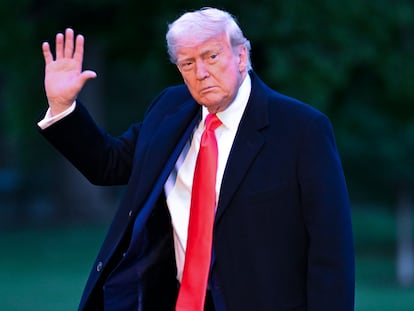Trump plans to ask the Supreme Court on Friday to keep the tariffs in place
White House lawyers say they’ll seek a fast-track remedy to block the court’s decision, warning of ‘irreparable harms’ if the tariffs are lifted

White House lawyers are working at full speed to salvage the administration’s trade strategy following Wednesday’s court ruling that struck down the bulk of its tariffs. On that same day, the administration filed an emergency request with the Court of International Trade to temporarily halt the implementation of the ruling.
On Thursday, they submitted a similar motion to a federal appeals court in Washington. In a 124-page filing, the government indicated that if these courts do not grant the suspension, they will take the matter to the Supreme Court as early as Friday in an effort to keep the tariffs in effect.
“Absent at least interim relief from this Court, the United States plans to seek emergency relief from the Supreme Court tomorrow to avoid the irreparable national-security and economic harms at stake,” the filing states, accompanied by multiple exhibits.
The Trump administration argues that “successful agreements the President has reached with multiple countries could be immediately unraveled” if the court ruling is applied. In reality, Trump has yet to secure a formal trade deal with any nation. He signed a non-binding preliminary agreement with the U.K. and negotiated tariff rollbacks with China — reversing duties he had previously imposed. That’s the extent of his trade achievements so far.
Thursday’s filing reiterates the same arguments the Trump administration has maintained throughout the case, namely that courts are not authorized to question the president’s decision to invoke emergency powers to impose tariffs. The administration also claims that Trump’s interpretation of the law should stand because, decades ago, the trade court permitted former president Richard Nixon to impose emergency tariffs under a similar statute. However, the ruling thoroughly analyzes that precedent and ultimately uses it to support its own judgment.
The government is requesting a stay on the ruling, arguing the potential damages are “plainly irreparable.” “Absent a stay, even if this Court ultimately upholds the tariffs, the CIT’s permanent injunction may have compromised delicate, time-sensitive foreign negotiations, perhaps irrevocably. And, absent a stay, the government will receive reduced revenue that it will be unable to recoup if the tariffs are ultimately upheld — another irreparable harm,” the filing argues.
Conservative majority
The Supreme Court currently has a conservative majority of six to three. Three of those justices were appointed by Trump himself, though that doesn’t guarantee a favorable outcome. The Court of International Trade’s decision was unanimous, made by three judges: one appointed by Trump, another by Ronald Reagan, and the third by Barack Obama.
In his increasingly authoritarian approach, Trump has repeatedly encroached on Congressional powers and stretched executive authority, prompting rulings that many of his actions were unconstitutional. On Wednesday, the U.S. Court of International Trade declared Trump’s blanket tariffs illegal, stating they violated both the Constitution and statutory law.
The ruling voids tariffs of 25% on imports from Canada and Mexico and 20% on those from China, which were justified under dubious claims of threats like fentanyl and immigration. It also nullifies so-called “reciprocal tariffs” announced on the proclaimed “Liberation Day,” which Trump later walked back to 10% following market pressure.
The administration is still preparing a full appeal on the core legal arguments, which has not yet been filed. Trump has remained silent for now, but several of his aides have attacked the judges for their decision. “We are living under a judicial tyranny,” Deputy Chief of Staff Stephen Miller posted on X on Thursday night. “The judicial coup is out of control,” he added.
Speaking on the conservative Fox Business channel, White House National Economic Council Director Kevin Hassett said, “I’m sure that when we appeal, that this decision will be overturned.” He claimed that “activist judges are trying to slow down something right in the middle of really important negotiations.”
According to Hassett, while Trump has other legal avenues to impose new tariffs, that is not the current plan. “We’re not planning to pursue those right now, because we’re very, very confident that this ruling is incorrect,” he said. The administration notified the court on Wednesday of its intention to appeal but has not yet done so.
The court’s decision undermines the Trump administration’s entire trade strategy — something the government itself admits in its request to suspend the ruling.
“So grave are the stakes for the Nation that four members of the President’s Cabinet took the extraordinary step of submitting declarations to the CIT, before its ruling, substantiating the immediate, catastrophic harms that would flow from enjoining the President’s tariff authority,” the filing states.
As in the previous filing to the trade court, the motion to the appeals court emphasizes concerns raised by senior officials: Commerce Secretary Howard Lutnick warned that lifting the tariffs would “collapse” recent agreements and endanger “dozens of similar arrangements.” Treasury Secretary Scott Bessent echoed that sentiment, stating the ruling “could shatter” ongoing negotiations with numerous countries and encourage retaliatory actions.
U.S. Trade Representative Jamieson Greer warned that an injunction could allow trade partners “to further distort the conditions of competition for U.S. exporters.” Secretary of State Marco Rubio cautioned that a court order “would cause significant and irreparable harm to U.S. foreign policy and national security.”
Sign up for our weekly newsletter to get more English-language news coverage from EL PAÍS USA Edition
Tu suscripción se está usando en otro dispositivo
¿Quieres añadir otro usuario a tu suscripción?
Si continúas leyendo en este dispositivo, no se podrá leer en el otro.
FlechaTu suscripción se está usando en otro dispositivo y solo puedes acceder a EL PAÍS desde un dispositivo a la vez.
Si quieres compartir tu cuenta, cambia tu suscripción a la modalidad Premium, así podrás añadir otro usuario. Cada uno accederá con su propia cuenta de email, lo que os permitirá personalizar vuestra experiencia en EL PAÍS.
¿Tienes una suscripción de empresa? Accede aquí para contratar más cuentas.
En el caso de no saber quién está usando tu cuenta, te recomendamos cambiar tu contraseña aquí.
Si decides continuar compartiendo tu cuenta, este mensaje se mostrará en tu dispositivo y en el de la otra persona que está usando tu cuenta de forma indefinida, afectando a tu experiencia de lectura. Puedes consultar aquí los términos y condiciones de la suscripción digital.
More information
Archived In
Últimas noticias
Most viewed
- Reinhard Genzel, Nobel laureate in physics: ‘One-minute videos will never give you the truth’
- Oona Chaplin: ‘I told James Cameron that I was living in a treehouse and starting a permaculture project with a friend’
- Pablo Escobar’s hippos: A serious environmental problem, 40 years on
- Why we lost the habit of sleeping in two segments and how that changed our sense of time
- Chevy Chase, the beloved comedian who was a monster off camera: ‘Not everyone hated him, just the people who’ve worked with him’









































